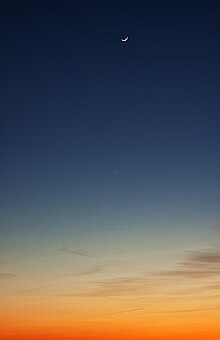
Chappuis absorption (French: [ʃapɥi]) refers to the absorption of electromagnetic radiation by ozone, which is especially noticeable in the ozone layer, which absorbs a small part of sunlight in the visible portion of the electromagnetic spectrum. The Chappuis absorption bands occur at wavelengths between 400 and 650 nm. Within this range are two absorption maxima of similar height at 575 and 603 nm.[1][2]
Compared to the absorption of ultraviolet light by the ozone layer, known as the Hartley and Huggins absorptions, Chappuis absorption is distinctly weaker.[3] Along with Rayleigh scattering, it contributes to the blue color of the sky, and is noticeable when the light has to travel a long path through the Earth's atmosphere. For this reason, Chappuis absorption only has a significant effect on the color of the sky at dawn and dusk, during the so-called blue hour.[4] It is named after the French chemist James Chappuis (1854–1934), who discovered this effect.[5]
- ^ Bogumil, Konstanze (2005). Absorptionsspektroskopie von Ozon und anderen, wichtigen, atmosphärischen Spurengasen mit dem SCIAMACHY-Satellitenspektrometer im ultravioletten bis nahinfraroten Spektralbereich (PDF) (Thesis) (in German). University of Bremen. pp. 21–26.
- ^ Brion, J.; Chakir, A.; Charbonnier, J.; Daumont, D.; Parisse, C.; Malicet, J. (1998). "Absorption Spectra Measurements for the Ozone Molecule in the 350–830 nm Region" (PDF). Journal of Atmospheric Chemistry. 30 (2): 291–99. Bibcode:1998JAtC...30..291B. doi:10.1023/A:1006036924364. S2CID 25037900.
- ^ Vázquez, M.; Pallé, E.; Rodríguez, P. Montañés (2010-03-12). The Earth as a Distant Planet: A Rosetta Stone for the Search of Earth-Like Worlds. Springer Science & Business Media. p. 159. ISBN 9781441916846.
- ^ Der Brockhaus Wetter und Klima : Phänomene, Vorhersage, Klimawandel (in German) (1. Aufl ed.). Leipzig: Brockhaus, F A. 2009. p. 54. ISBN 9783765333811. OCLC 316287956.
- ^ Hoeppe, Götz (2007). Why the Sky is Blue: Discovering the Color of Life. Princeton University Press. pp. 238–53. ISBN 978-0691124537.